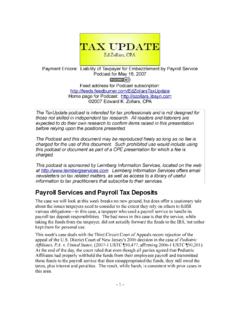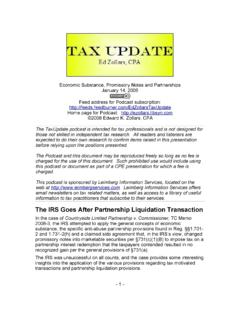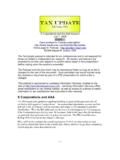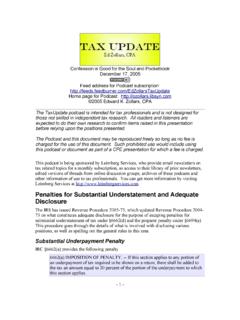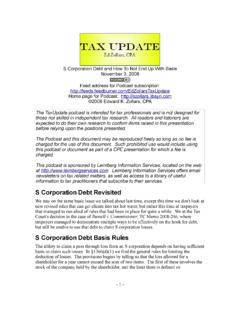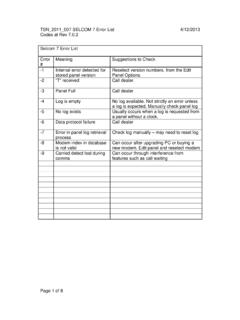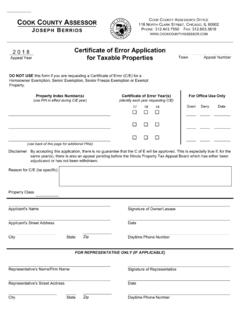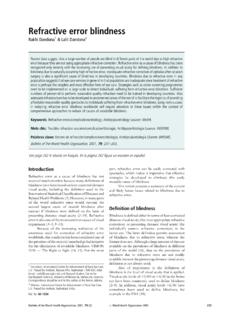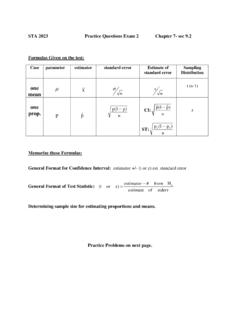Transcription of 2008-03-17 CPA Says Error - Ed Zollars
1 CPA says Error , IRS says Method March 17, 2008 Feed address for Podcast subscription: Home page for Podcast: 2008 Edward K. Zollars , CPA The TaxUpdate podcast is intended for tax professionals and is not designed for those not skilled in independent tax research. All readers and listeners are expected to do their own research to confirm items raised in this presentation before relying upon the positions presented. The Podcast and this document may be reproduced freely so long as no fee is charged for the use of this document. Such prohibited use would include using this podcast or document as part of a CPE presentation for which a fee is charged. This podcast is sponsored by Leimberg Information Services, located on the web at Leimberg Information Services offers email newsletters on tax related matters, as well as access to a library of useful information to tax practitioners that subscribe to their services.
2 Mathematical Error or Accounting Method? The issue this week involves the question of the difference between a mathematical Error and an accounting method an issue whose answer was to determine if the taxpayers in the case of Huffman v. Commissioner, a case decided last week by the Sixth Circuit Court of Appeals, sustaining the Tax Court s 2006 decision in this case (126 322). We ll look at the basic issue of a method of accounting, errors , the difference in the two and how both the Tax Court and the Sixth Circuit analyzed which side of the divide the situation in the Huffman case fell on. Accounting Methods Internal Revenue Code 446 governs the general rules for methods of accounting. The general rule of 446(a) indicates that the taxpayer s taxable income shall generally be computed under the method of accounting the CPA says Error , IRS says Method Podcast of March 17, 2008 Feed - 2 - taxpayer uses to compute its income in keeping its books.
3 However, 446(b) provides that if the taxpayer has no method of accounting that has been regularly used, or the method used does not clearly reflect income, the taxpayer shall compute its income under a method of accounting that, in the opinion of the IRS, does clearly reflect income. 446(c) provides a list of broadly available methods of accounting for a taxpayer, while 446(d) provides that if a taxpayer is involved in more than one trade or business, each one may use a different method of accounting. The code indirectly imposes a consistency requirement for methods of accounting. Taxpayers generally need the permission of the IRS to change a method of accounting. Those two provisions provide: (e) Requirement respecting change of accounting method Except as otherwise expressly provided in this chapter, a taxpayer who changes the method of accounting on the basis of which he regularly computes his income in keeping his books shall, before computing his taxable income under the new method, secure the consent of the Secretary.
4 (f) Failure to request change of method of accounting If the taxpayer does not file with the Secretary a request to change the method of accounting, the absence of the consent of the Secretary to a change in the method of accounting shall not be taken into account-- (1) to prevent the imposition of any penalty, or the addition of any amount to tax, under this title, or (2) to diminish the amount of such penalty or addition to tax. Thus once we have something that is identified as a method of accounting, we must continue to use it until such time as the IRS allows us to change that method. Note that while 446(b) gives the IRS the right to force a taxpayer to change from a method that does not clearly reflect income, the provision doesn t allow a taxpayer itself to make such a change without complying with the provisions of 446(e) to request permission to change. That is true even if the method of accounting being used is an impermissible method of accounting nothing in 446 allows taxpayers to fix being on an CPA says Error , IRS says Method Podcast of March 17, 2008 Feed - 3 - impermissible method without the permission of the Should consent be obtained, or should the taxpayer s method of accounting be found impermissible and the IRS propose to move the taxpayer to a method that does clearly reflect income, the mechanics of handling the conversion from one method to another to assure that items are not double reported or never reported are found in 481.
5 Generally 481(a) indicates that we need to create an adjustment to deal with these issues. That provision says : (a) General rule In computing the taxpayer's taxable income for any taxable year (referred to in this section as the "year of the change")-- (1) if such computation is under a method of accounting different from the method under which the taxpayer's taxable income for the preceding taxable year was computed, then (2) there shall be taken into account those adjustments which are determined to be necessary solely by reason of the change in order to prevent amounts from being duplicated or omitted, except there shall not be taken into account any adjustment in respect of any taxable year to which this section does not apply unless the adjustment is attributable to a change in the method of accounting initiated by the taxpayer. 481(b) outlines the basic three year spread mechanism for substantial changes, but then goes on to authorize the IRS to write regulations to generally govern the mechanics of implementing this section.
6 It reads: (c) Adjustments under regulations 1 Note that the IRS does regularly publish and update automatic approval for change and nonautomatic approval Revenue Procedures. On October 29, 2007 the IRS published Notice 2007-88, proposing a revision to these procedures ones the notice indicates are currently contained principally in Rev. Proc. 2002-9, 2002-1 327, as modified and clarified by Announcement 2002-17, 2002-1 561, modified and amplified by Rev. Proc. 2002-19, 2002-1 696, and amplified, clarified and modified by Rev. Proc. 2002-54, 2002-2 432 ("automatic consent process") and Rev. Proc. 97-27, 1997-1 680, as modified and amplified by Rev. Proc. 2002-19, as amplified and clarified by Rev. Proc. 2002-54 ("nonautomatic consent process"). CPA says Error , IRS says Method Podcast of March 17, 2008 Feed - 4 - In the case of any change described in subsection (a), the taxpayer may, in such manner and subject to such conditions as the Secretary may by regulations prescribe, take the adjustments required by subsection (a)(2) into account in computing the tax imposed by this chapter for the taxable year or years permitted under such regulations.
7 These provisions are needed because the general rule for taxes is that each year stands on its own we have an annual accounting for taxes, along with general limitation on assessment and claims for refund that runs for three years from the due date of the return (or the date the return was filed). Sometimes it s not easy to determine what exactly is a method of accounting (which is subject to the permission requirement and the 481 pickup of the cumulative adjustment) and the following items which don t require either: Estimate as we know from the recitation we find in full disclosure GAAP statement notes, accounting necessarily involves a number of estimates. If we simply have a modification of an estimate, that is not a method of accounting, but simply a change in estimate. So long as the method of computing the estimate produced a valid result for year 1, that year cannot be adjusted by the IRS, even if in year 2 the taxpayer used a different way to come up with the required estimate and the taxpayer won t need permission to make such changes in how it came up with the estimates for the return.
8 Mathematical or posting errors if a taxpayer merely fouls up their books and manages to erroneously charge $100 of office supplies to federal income tax expense, that is not a method of accounting issue. errors can be corrected via an amended income tax return there is no IRS permission required to correct such an Error , unlike the need to get permission to change an accounting method. Similarly, on examination the IRS can force the taxpayer to recognize the effect of correcting this matter without having to clear the clearly reflects income hurdle it must clear to invoke 446(b) s authority to change a taxpayer s accounting method. This latter category is the key matter in the case at hand did we have a mathematical Error or an accounting method? Mathematical errors Reg. contains much more detail about what is and is not a method of accounting the other regulations under 446 contain guidance in narrow areas, so that if an issue doesn t fall into one of those narrow areas, Reg.
9 Will CPA says Error , IRS says Method Podcast of March 17, 2008 Feed - 5 - govern the question of whether or not we have an accounting method and, by extension, how changes can be made. Reg. (e)(2)(ii) contains our basic guidance on what is an accounting method, telling us indirectly how to determine if we have a method: A change in the method of accounting includes a change in the overall plan of accounting for gross income or deductions or a change in the treatment of any material item used in such overall plan. Although a method of accounting may exist under this definition without the necessity of a pattern of consistent treatment of an item, in most instances a method of accounting is not established for an item without such consistent treatment. A material item is any item that involves the proper time for the inclusion of the item in income or the taking of a deduction.
10 Changes in method of accounting include a change from the cash receipts and disbursement method to an accrual method, or vice versa, a change involving the method or basis used in the valuation of inventories (see sections 471 and 472 and the regulations under sections 471 and 472), a change from the cash or accrual method to a long-term contract method, or vice versa (see ), certain changes in computing depreciation or amortization (see paragraph (e)(2)(ii)(d) of this section), a change involving the adoption, use or discontinuance of any other specialized method of computing taxable income, such as the crop method, and a change where the Internal Revenue Code and regulations under the Internal Revenue Code specifically require that the consent of the Commissioner must be obtained before adopting such a change Some key factors emerge from this definition. First, the item involves needs to be material which is defined to mean it involves the timing of the inclusion of an item of income or taking a deduction on the return.

